
An hour’s drive from the lush and fertile Bluegrass region of Kentucky, and across the eponymous river, lies Ohio. Better known on the national sporting scene for college football and the loyal but often dispirited fan bases of its professional teams, Ohio’s contribution to the Thoroughbred racing landscape, by comparison, has been relatively modest.
Nonetheless, Ohioans can claim justifiable pride in some of their native Thoroughbred sons and daughters. Imp, a star mare of the late 1890s, is the only known Ohio-bred in the Racing Hall of Fame. Not many years later, Wintergreen scored as the favorite in the 1909 Kentucky Derby.
Two other Ohio colts failed as Kentucky Derby favorites in recent decades, but achieved notable successes elsewhere. Air Forbes One, seventh in the 1982 Derby, coincidentally stood at Wintergreen Farm in Kentucky and sired the champion filly Yanks Music.
Harlan’s Holiday also ran seventh at Churchill Downs, in 2002, but was a multiple Grade 1 winner and Dubai World Cup (G1) runner-up. He, too, sired a champion in Shanghai Bobby, but his lasting impact on the breed has become more pronounced of late through his son Into Mischief.
Ohio has produced a smattering of other graded stakes winners over the years, including the Belmont Stakes (G1)-placed Kingpost. But one of its seemingly forgotten sons deserves revisiting, in part due to a weight-carrying prowess that would have made some of the more nationally recognizable legends of that realm blush.
Royal Harmony proved time and again to be the true Iron Horse of Ohio.
***
Bred by John Nashlund, a Swedish immigrant and building contractor, Royal Harmony was foaled in 1964 at what became Happy Times Farm in Morrow, northeast of Cincinnati. He was sired by Royal Note, a precociously fast juvenile of 1954 who won six of eight starts, including the Bashford Manor and Arlington Futurity. Royal Harmony’s dam was Desatino, later described by trainer Pat Devereux as a “big, old, mean mare.”
Acquired by Devereux in lieu of an unpaid training bill, Royal Harmony arrived at the conditioner’s central Kentucky barn with a hole in his side.
“We didn’t know why he had it when he first came to us, but we found out his mother killed the foal before him,” Devereux said. “I would say the mare probably did it to him – bit the side out of him.”
Desatino never produced another foal and Royal Harmony inherited a bit of an ornery streak during his racing career.
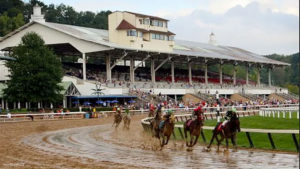
Royal Harmony raced in the colors of Devereux’s father, Tom, and debuted in the summer of 1967 at River Downs, where he’d become a much-loved figure. Like his sire, he showed an ability to win from the outset and proved a highly capable sprinter. In only his second start, Daily Racing Form timed Royal Harmony’s win over 6 furlongs in 1:09 2/5, only one-fifth of a second off River Downs’ then three decade-old track record.
Second in his stakes debut on the turf at River Downs later that year, Royal Harmony would score his first added-money triumph in a division of the Inaugural Stakes, a minor 6-furlong event at Latonia, against open company.
Royal Harmony’s 1968 stakes campaign consisted primarily of sprints restricted to Ohio-bred or -owned rivals. He won four of them, but was poised to expand his horizons as a 5-year-old.
***
Royal Harmony left the world of sprinting largely behind in 1969, and though he stayed in the Ohio-bred ranks for all but a few stakes appearances that season, they proved competitive enough.
Displaying versatility by winning two stakes on the grass, at River and Thistledown, Royal Harmony later won the first of his three consecutive victories in the Governor’s Buckeye Cup at River Downs over 1 1/16 miles. In between that and a track-record setting score in the All-American Handicap at Beulah Park over 1 1/8 miles, Royal Harmony stayed home to compete in the Fayette Handicap at Keeneland.
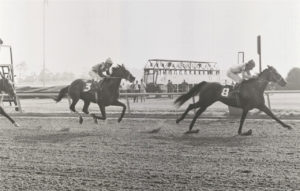
A Grade 2-quality event then as today, the 1 1/16-mile Fayette included T. V. Commercial and Miracle Hill, both of whom had won multiple stakes at Keeneland in an era when only about six open to male horses were offered annually during the track’s two meets. Another prominent entrant was Pattee Canyon, who would prove among the nation’s top turf mares in 1970.
A 7-1 chance, Royal Harmony took command around the far turn and held off the Argentinean-bred Otomano II, with the other major contenders farther behind.
“I’ve got just one wish, that this horse stays the way he is,” said a delighted Pat Devereux on a warm October afternoon.
Staying the way he was meant taking the bad with the good, and Royal Harmony could be bad after a defeat.
“When he wins he’s the easiest horse in the world to get along with, gentle as a kitten,” Devereux said. “When he loses, though, you have to watch out. He’s mean, then. He doesn’t like to get beat, he knows what it’s all about.”
A case in point was Royal Harmony’s season-ending loss in the 1969 Clark Handicap at Churchill Downs, in which he finished fourth.
“After he got beat they were trying to take the (protective) patches off his feet at the barn and he sent them flying,” said Pat Devereux Jr., who followed in his father’s footsteps into the training field.
***
Royal Harmony’s 1970 campaign at age six was a particularly ambitious one. While still tending to his domain in Ohio-bred stakes, the gelding also frequently ventured to Detroit and Chicago for major stakes.
One unlucky incident occurred that summer in the Benjamin F. Lindheimer Handicap, at the time one of Arlington‘s most lucrative grass events. Although favored, Royal Harmony was interfered with by Fast Hilarious and could only manage to cross the wire in third. The stewards disqualified Fast Hilarious from first and placed him third behind Royal Harmony, thus elevating Te Vega, a fellow Ohio-bred, to first.
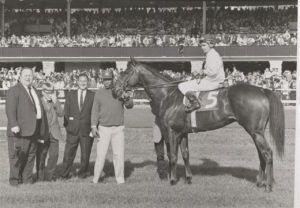
Fast Hilarious had also beaten Royal Harmony, and champion older male Nodouble, earlier that summer in the Michigan Mile and One-Eighth Handicap at Detroit, but Royal Harmony would eventually get his revenge in the 1970 renewal of the Fayette. In addition to those two, that Fayette field also included that year’s upset winner of the Kentucky Derby, Dust Commander.
Sent away at 4-1, Royal Harmony eked out a neck victory over the errant Fast Hilarious, who was again disqualified and placed third, this time behind Dust Commander, for interference.
“This proves that the victory last year was no fluke,” Devereux said.
Perhaps the bigger story of Royal Harmony’s 1969 campaign were the increasingly stiff weights Devereux ruefully began accepting for his charge in Ohio. After successfully toting 130 pounds in the Hamilton County Handicap on turf, Royal Harmony was back the next week at River Downs to win the Cincinnati Special Handicap on dirt carrying 134. That was also Royal Harmony’s impost when he defeated Te Vega in the Clevelander Handicap at Thistledown, and he carried 135 pounds when taking the Governor’s Buckeye Cup a second time.
“I’m afraid weight will kill him someday, but, so far, he has answered every call. He is quite a horse with plenty of heart,” Devereux said.
Incredibly, the weights got higher after the Fayette. Returning to state-restricted company, Royal Harmony packed 139 pounds and won the All-American at Beulah for a second straight year. Later, after winning the Chicago Today Handicap at Sportsman’s Park under 129 pounds, Royal Harmony was assigned 141 pounds for the Stanley “Skip” Jechura Handicap against Ohio-breds at Raceway Park in Toledo.
Royal Harmony won that, too, again beating Te Vega.
***
By 1971, the 7-year-old Royal Harmony had been virtually weighted out of state-bred stakes, though he ultimately had to return to them when open stakes generally proved too difficult.
After finishing second in the Michigan Mile and the Cincinnati Special, the latter under 139 pounds, Royal Harmony began making his first road trips east. As was customary, the “loner” traveled solo to his appointments, chauffeured by Devereux.
“He prefers to ride alone,” said Devereux, who explained Royal Harmony favored travel by trailer rather than van. “He just doesn’t like company when traveling.”
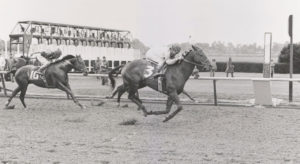
Royal Harmony fared poorly in the Amory L. Haskell Handicap at Monmouth Park, but later acquitted himself on consecutive Saturdays at Aqueduct. He finished third in the Brooklyn Handicap at odds of 37-1 and then second to eventual grass champion Run the Gantlet in the Tidal Handicap.
After finishing fourth to New York’s leading turf filly, Princess Pout, in the Lindheimer at Arlington, Royal Harmony was sent back to Ohio in search of a much-needed win. A 138-pound impost wasn’t enough to stop him in taking his third Governor’s Buckeye Cup at River Downs by six lengths. It was his ninth and final stakes win at the Cincinnati oval.
Royal Harmony attempted a three-peat twice more that fall. He captured the Fayette by three-quarters of a length, becoming the first horse in Keeneland history to turn a hat trick in the same stakes. One race later, Royal Harmony accepted a staggering, career-high 143 pounds for the All-American at Beulah.
He won by four lengths.
***
Age, perhaps more than weight, began to catch up as Royal Harmony turned eight in 1972. After trips to Chicago, Omaha, and Detroit yielded only one stakes win, and that via disqualification, Royal Harmony made his swan songs versus Ohio-bred foes.
Unfortunately, weight did not help Royal Harmony when facing comparatively young and talented guns. He finished second in the Clevelander Handicap at Thistledown carrying 136 pounds, and third in the Governor’s Buckeye Cup toting 135 pounds. Royal Harmony’s final stakes appearance was his third attempt at the Michigan Mile. He finished seventh.
Unbeknownst to connections at the time, Royal Harmony’s career was over. Voted Ohio’s Horse of the Year three times, his record was 105-38-30-15 with victories in 22 of 61 stakes attempts. His earnings of $587,164, a then-record for an Ohio-bred, would be more than $3.5 million today in inflation-adjusted figures, second only to Harlan’s Holiday.
***
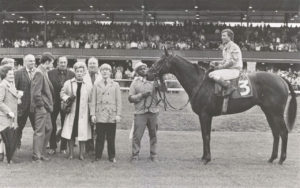
“Royal Harmony’s a great horse, but everybody is trying to break him down,” or thoughts to that effect, were common public utterances from Pat Devereux throughout the horse’s career.
Royal Harmony did not race at age nine, but showed signs that he wasn’t yet ready to retire. While attempting a comeback at age 10, he fatally injured his left foreleg during a workout at the Kentucky Horse Center in Lexington in February 1974.
“I was going to give him two more workouts before taking him back to the races,” said an embittered Devereux, who scoffed at the idea of running him in Ohio again but offered conflicting views on what he felt was the underlying cause of Royal Harmony’s accident.
It was a years-long balancing act with Royal Harmony whether to run out of state, where the money and weights were good but the odds longer, or in Ohio where the money and odds were good but the weight penalties severe. Five decades on, the record shows the Iron Horse of Ohio ran and achieved to the best of his ability no matter where he raced.
As Pat Devereux succinctly summed up, “That horse carried the world on his shoulders.”
Sources:
Chicago Tribune
Cincinnati Enquirer
Lexington Herald-Leader
Louisville Courier-Journal



